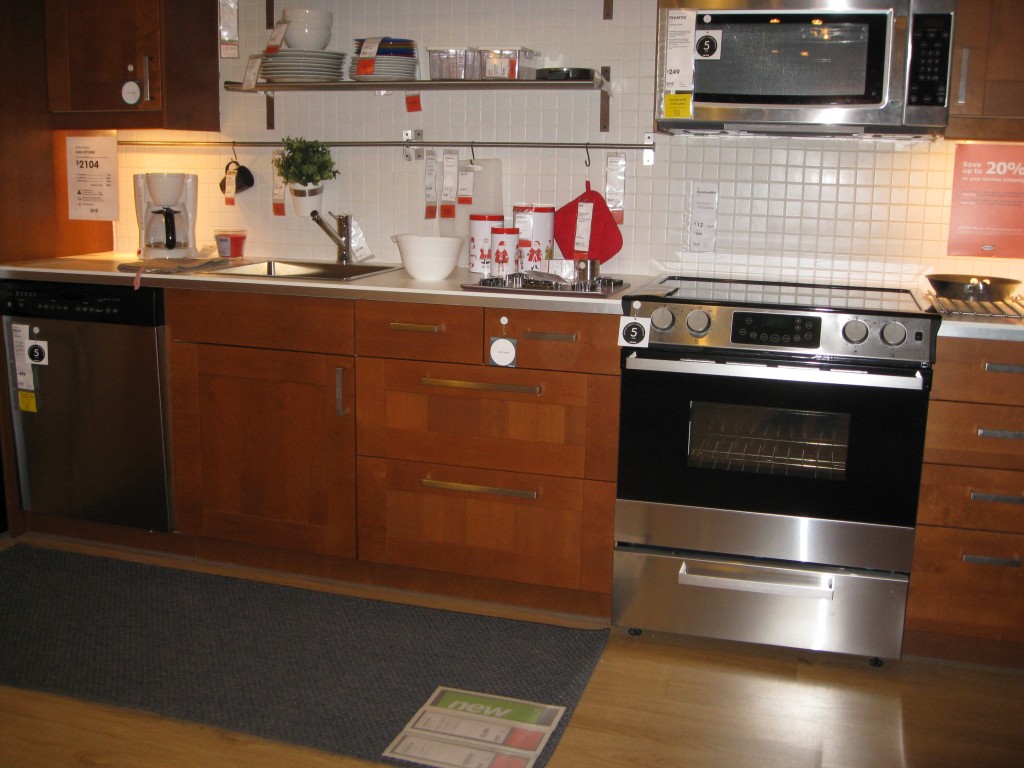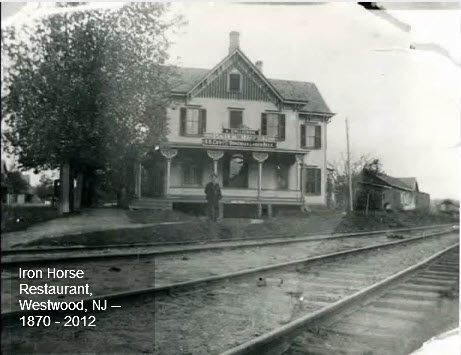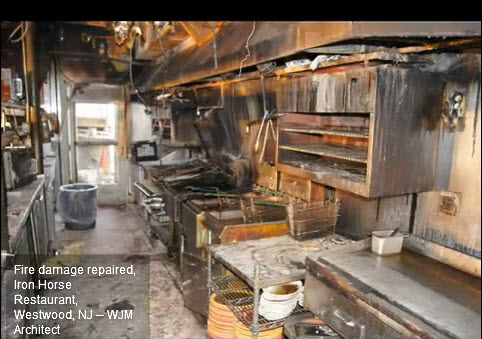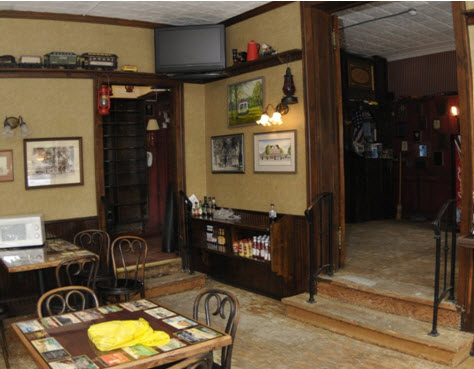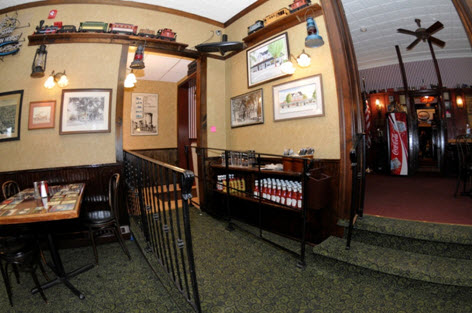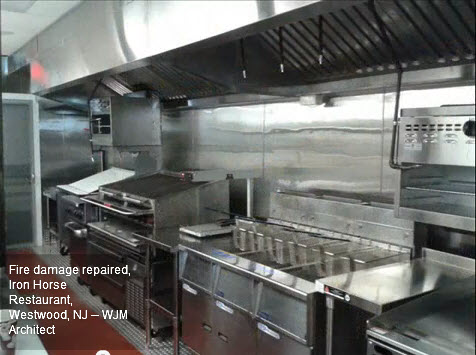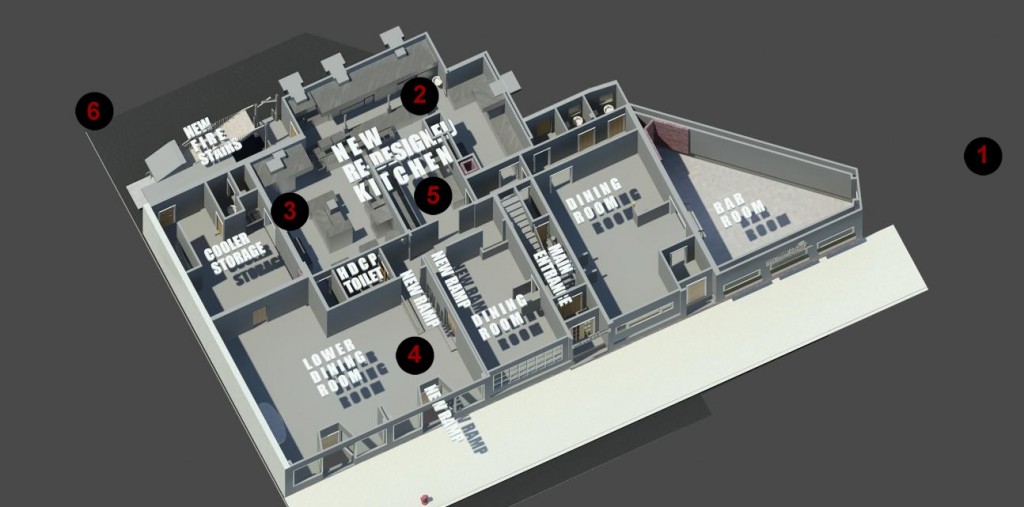It is summer and it is time to take vacations! As you travel you might stay at hotels or motels. People with disabilities also enjoy traveling and the ADA has requirements for guest rooms in hotels (as well as other type of transient lodging) that will accommodate mobility impairments, visual impairments and hearing impairments as well. This newsletter outlines a few of the requirements for designing transient lodging facilities for people with disabilities.
Guest Rooms with Mobility features
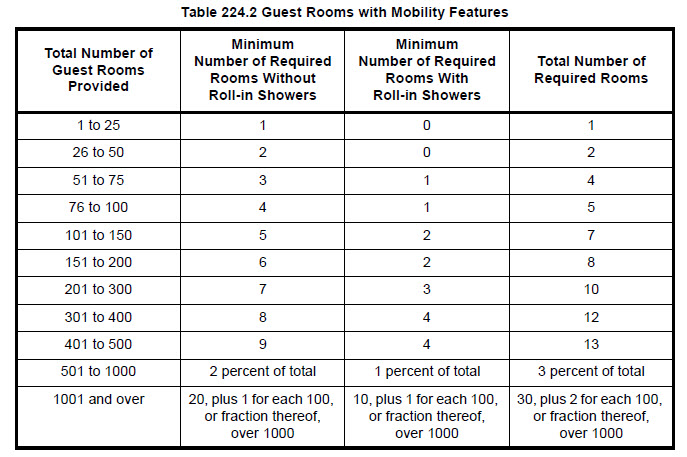
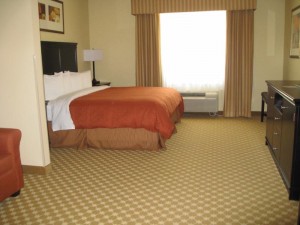
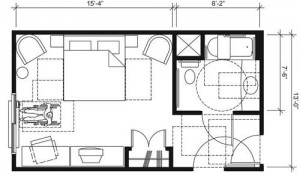
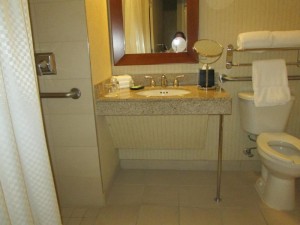
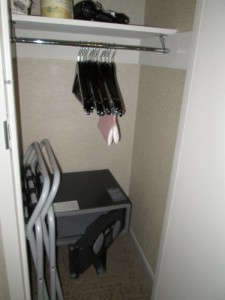
Guest Rooms with Communication features
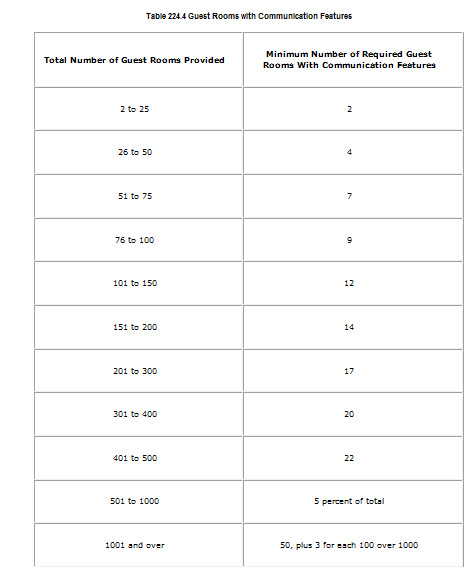
- Where emergency warning systems are provided, alarms complying with 702 shall be provided in rooms with communication features
- Visible notification devices shall be provided to alert room occupants of incoming telephone calls and a door knock or bell. Notification devices shall not be connected to visible alarm signal appliances. Telephones shall have volume controls compatible with the telephone system and shall comply with 704.3. Telephones shall be served by an electrical outlet complying with 309 located within 48 inches (1220 mm) of the telephone to facilitate the use of a TTY
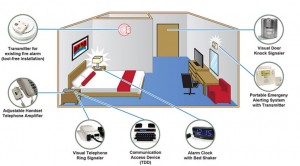
Need CEUs
If you want to learn more about these standards, be sure to check out my books:

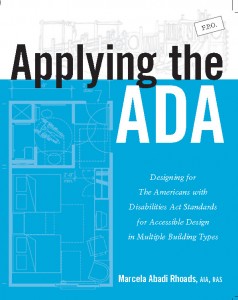
If you have any questions about these or any other topics, please feel free to contact me anytime.
Marcela Abadi Rhoads, RAS #240
Abadi Accessibility
214. 403.8714
marhoads@abadiaccess.com
www.abadiaccess.com
Employee Work Areas
Monday, May 2nd, 2016Work Areas
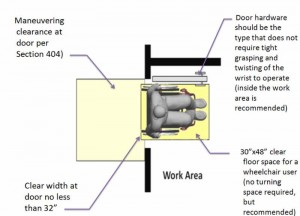
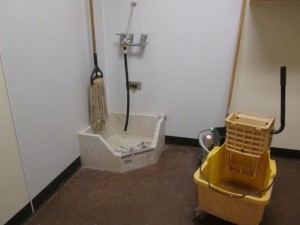

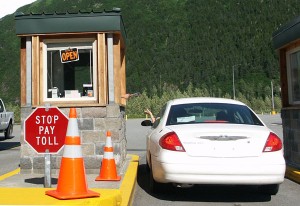
This toll booth is less than 300 s.f. and elevated more than 7″ a.f.f. and therefore do not require an accessible route to it or the ability to approach it and enter it.
The Standards sometimes provide additional guidance through “advisories”. These are NOT requirements, but they are suggestions that might make your design a better one. Below are some of the advisories on work areas:
Advisory 203.9 Employee Work Areas. Although areas used exclusively by employees for work are not required to be fully accessible, consider designing such areas to include non-required turning spaces, and provide accessible elements whenever possible.
Under the Title I of the ADA, employees with disabilities are entitled to reasonable accommodations in the workplace; accommodations can include alterations to spaces within the facility. Designing employee work areas to be more accessible at the outset will avoid more costly retrofits when current employees become temporarily or permanently disabled, or when new employees with disabilities are hired.

In addition to approach, enter and exit, the employee work area shall also comply with the following sections of the ADA Standards: 206.2.8, 207.1, and 215.3. These will be explained in detail below.
206.2.8 Employee Work Areas. Common use circulation paths within employee work areas shall comply with 402.
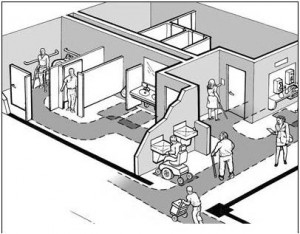
The circulation path should meet the requirements for ADA Section 402 which includes a minimum 36″ width along the circulation path.
EXCEPTIONS:
1. Common use circulation paths located within employee work areas that are less than 1000 square feet (93 m2) and defined by permanently installed partitions, counters, casework, or furnishings shall not be required to comply with 402.2.
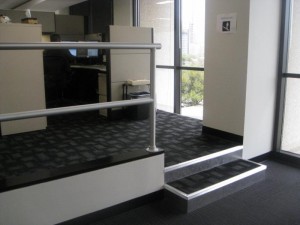
This employee work area is less than 1,000 s.f. and therefore the step is allowed
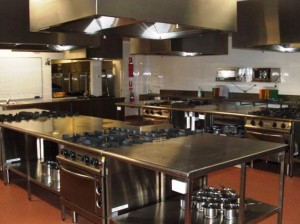
This commercial kitchen has equipment that is an integral part of the work area. The 36″ min. circulation path in this space is not required to comply due to the location of the work area equipment.
Advisory 206.2.8 Employee Work Areas
Exception 2. Large pieces of equipment, such as electric turbines or water pumping apparatus, may have stairs and elevated walkways used for overseeing or monitoring purposes which are physically part of the turbine or pump. However, passenger elevators used for vertical transportation between stories are not considered “work area equipment” as defined in Section 106.5.

An accessible route/circulation path up to the elevated walkway used to monitor work area equipment is not required to be provided.
Common use circulation paths located within exterior employee work areas that are fully exposed to the weather shall not be required to comply with 402.
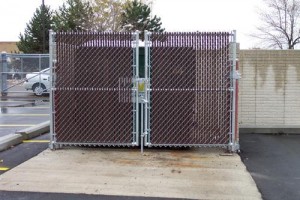
A dumpster is considered an extension of a work area. Although a circulation path within the work area might be required, because the dumpster is located on the exterior and fully exposed to the weather, a circulation path will not be required.
Advisory 206.2.8 Employee Work Areas Exception 1. Modular furniture that is not permanently installed is not directly subject to these requirements
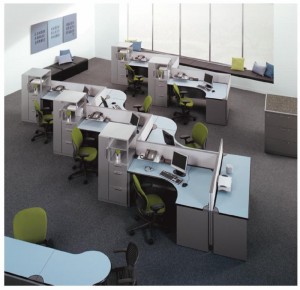
The modular furniture in an open office is not required to be installed so that there is a minimum 36″ width is provided. They are essentially exempted from having to comply (unless they are permanently attached to the ground or wall)
207.1 Employee work areas are required to have an accessible means of egress per the requirements in the IBC
215.3 Employee Work Areas. Where employee work areas have audible alarm coverage, the wiring system shall be designed so that visible alarms complying with 702 can be integrated into the alarm system.
Employee Areas that are not work related
The requirements thus far have been for areas that are considered part of the “work” areas in a space. But there are other areas that are also part of an employee area, but are not related to the work they perform. Those areas that are NOT related to their job description will not be exempted and must comply. Below are a few examples of areas that might be for employees only, but must be fully compliant with the Standards:
Break Rooms
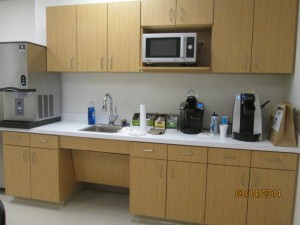
The sink in this break room and the height of the counter are required to comply. The microwave shown in this photo is not permanently attached and therefore the reach range is not required to comply.
LEED Showers for employees
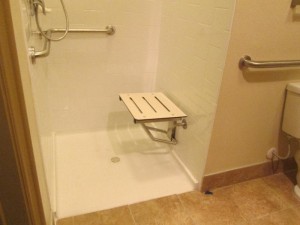
Some showers that are accessed through a private office have less requirements. But if it is a common use shower for all employees to use, then they must comply with section 608
Employee Restrooms

All restrooms including employee restrooms must comply with the requirements in Sections 603-606
Employee Locker Rooms
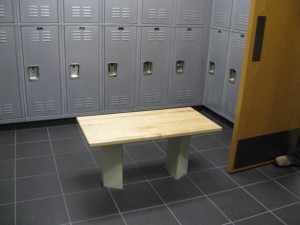
The lockers as well as the bench in this locker/dressing room must comply with the Standards
Employee dining counters

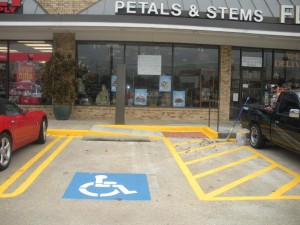

Barrier Free Day in Dallas Texas
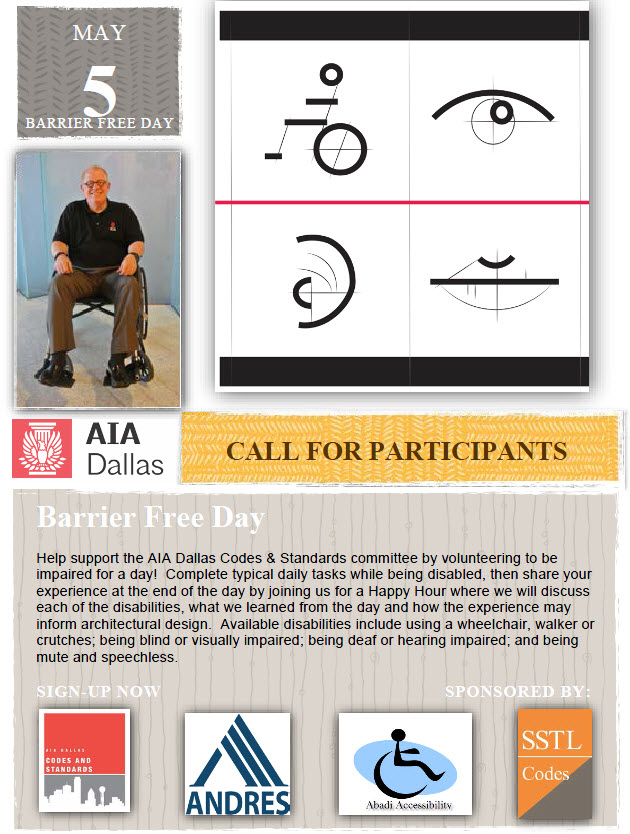
Need CEUs
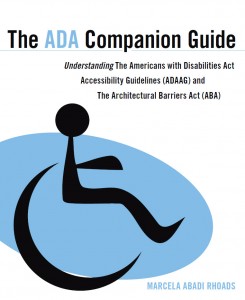

They are available for sale now. (also available as an e-book)
If you have any questions about these or any other topics, please feel free to contact me anytime.
Marcela Abadi Rhoads, RAS #240
Abadi Accessibility
214. 403.8714
marhoads@abadiaccess.com
www.abadiaccess.com
Fair Housing
Monday, February 1st, 2016Which projects have to comply?
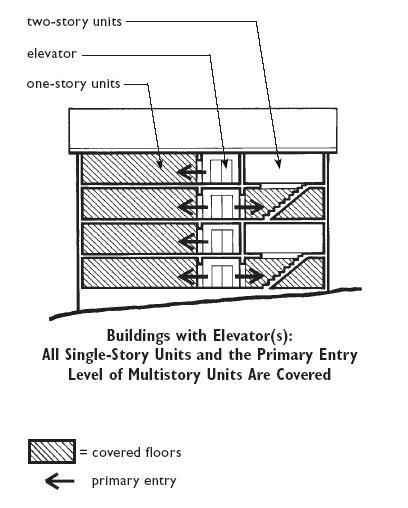
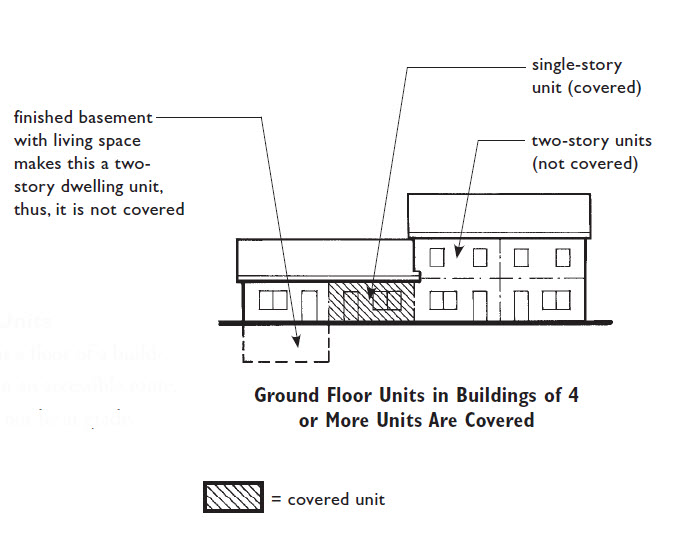
Seven Requirements
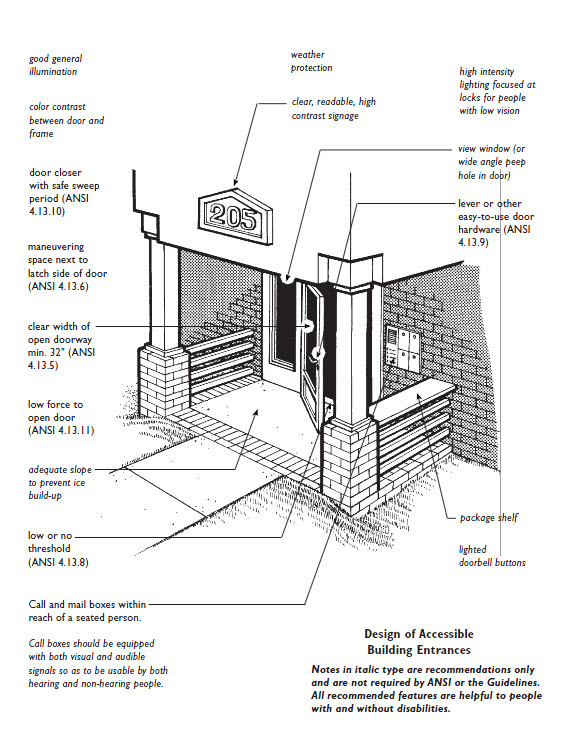

wide to allow passage by persons in wheelchairs.
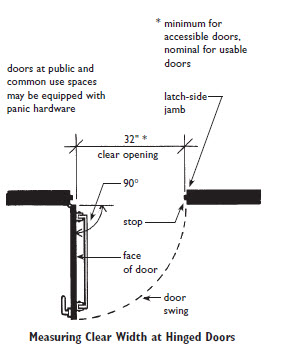
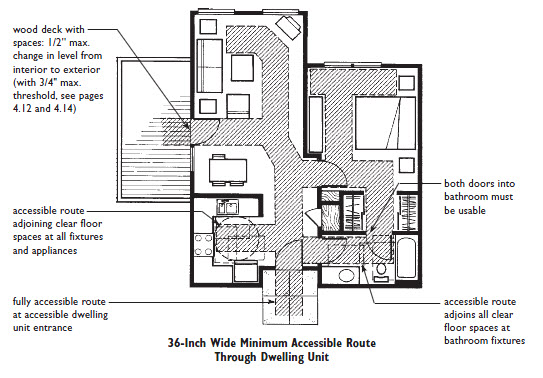
Controls in Accessible Locations:
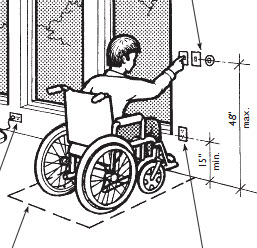
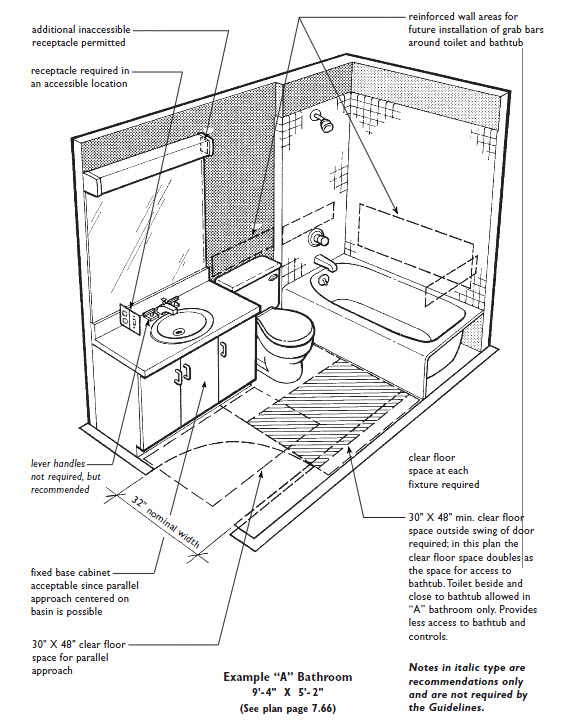
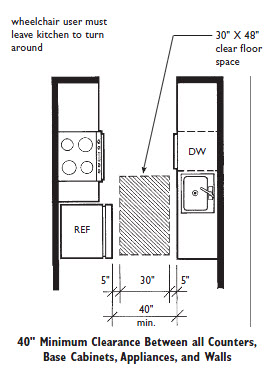
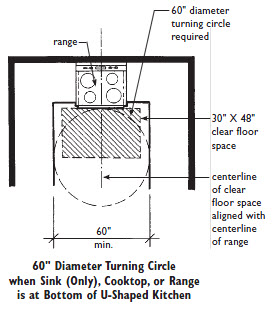
Inspector’s Corner
Requirement 1 of the Fair Housing Act states that an accessible entrance is required to the dwelling units. This photo shows three steps up to the stoop which leads to the entrance, and no ramp or lift to get them to the stoop. This unit does not meet the requirement.
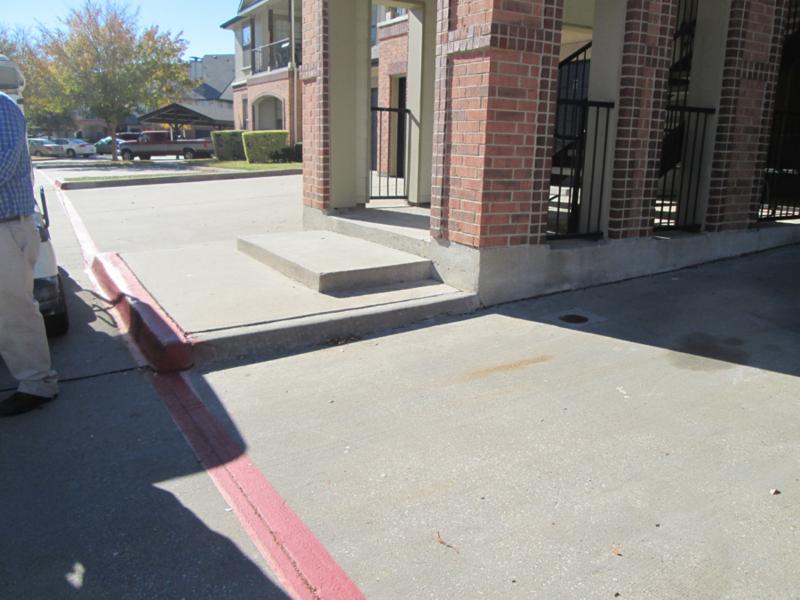
Need CEUs
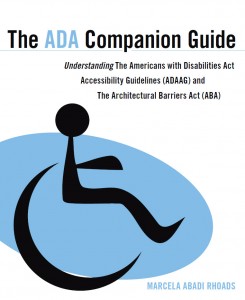

If you have any questions about these or any other topics, please feel free to contact me anytime.
Marcela Abadi Rhoads, RAS #240
Abadi Accessibility
214. 403.8714
marhoads@abadiaccess.com
www.abadiaccess.com
Accessible Residences
Sunday, March 24th, 2013In the new ADA there are residential scoping and technical guidelines. But these guidelines only deal with Federally funded housing, residences in places of education or social service establishments that have dwelling within. Other residential facilities, do not fall under the ADA, but Fair Housing or Model Codes. There are four types of residential projects, but only two are required to follow the ADA Standards.
- Single Family Housing
- Multi-Family Housing
- Federally funded multi-family housing
- Residential facilities as defined by ADA
This newsletter will explain single and multi-family housing that are not required to meet ADA Standards.
Privately funded Multi-Family Housing
The Fair Housing Act requires that any multi-family project be made accessible to the disabled community. Therefore the owner of a multi-famly property cannot discriminate against a family or individual who is disabled on the grounds that the property is not accessible.
ALL multi-family housing projects are required to be accessible per the Fair Housing Act. This includes apartment complexes, and even condominiums as long as there are four or more units in the property.
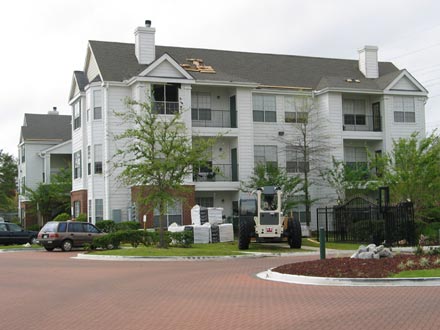
Here are the requirements from the fair housing act guidelines:
– At walk-ups (no elevator) ALL ground level units must meet the requirements
– in an elevator building ALL units must meet the requirements
Building code and ADA does have percentages for how many units are required to be fully compliant vs. adaptable, but fair housing does not. Therefore all units must be designed using the minimum guidelines listed below.
There are seven requirements:
1) Accessible building entrance on an accessible route: At least one entrance into the building or unit
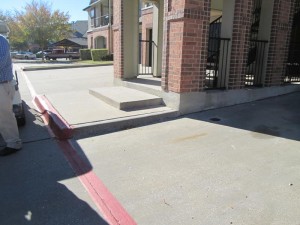
2) Accessible and Usable public and common use areas: Places such as parking lots, mail boxes, recreational area, lobbies, laundry areas, community building must be accessible and usable.
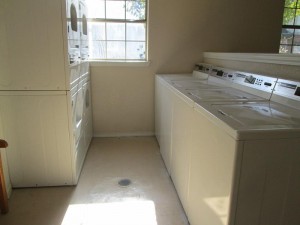
3) Usable doors: all doors that allow passage must be wide enough (32″ nominal) and the main entrance must have proper hardware
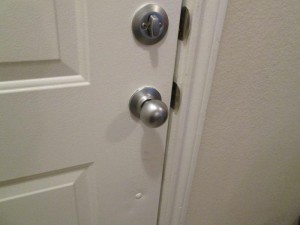
4) Accessible route into and through the covered dwelling unit

5) Light switches, Electrical outlets, thermostat and other environmental controls in accessible locations
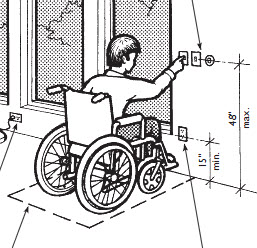
6) Reinforced walls in bathrooms for future installation of grab bars

7) Usable kitchens and bathrooms: Should be designed and constructed so an individual in a wheelchair can maneuver in the space provided. No knee clearances are required
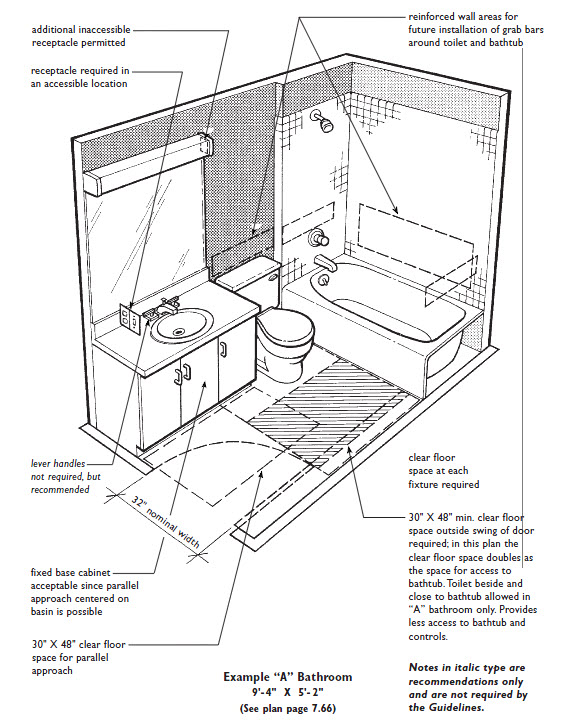
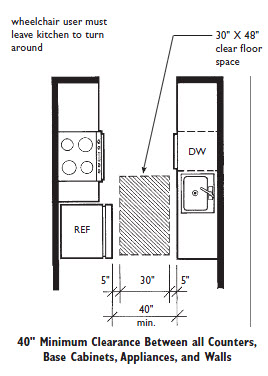
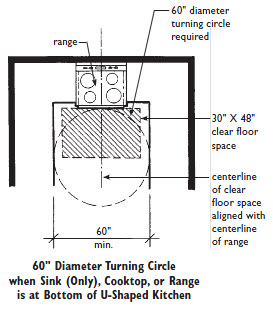
To understand more in detail the requirements, visit the Fair Housing Act website or click here for the Design Manual
Single Family Housing
Single family homes, duplexes, triplexes and multi-story townhouses are not required to be accessible by any accessibility standards. Therefore any single family home development are essentially exempted from having to be accessible to the disabled.
A new movement called “Aging in Place” are advocating for remodeling or retro-fitting homes in order to make them more usable to the disabled and more universally designed so that families can stay together as they age. Below are some of the enhancements we did in a kitchen of a family with a disabled mother and son. It is also good for their able body husband.
Before the upgrades:
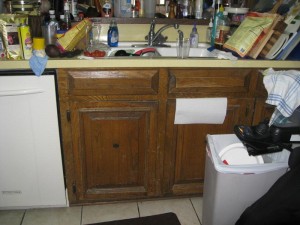
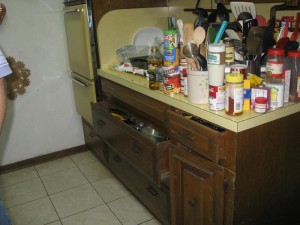
After the upgrades:
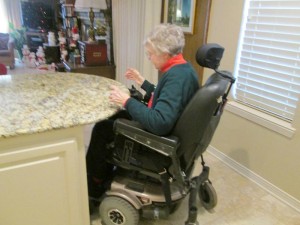
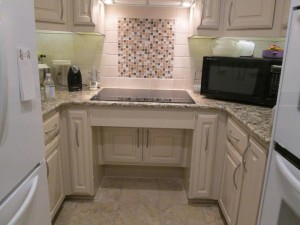
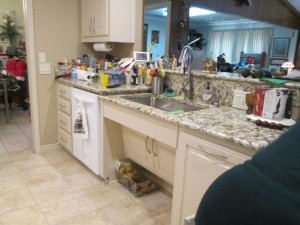
Inspector’s Corner
This was a remodel of a single family home. We installed a pull down shelving which made the shelves within reach range
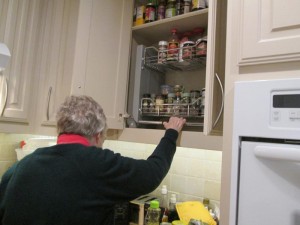
Click here to watch the video of pull down shelving
For more information
If you want to learn more about the new Standards, The ADA Companion Guide explains the 2004 ADAAG Guidelines with commentary and explanations throughout. The 2004 Guidelines were adopted by the DOJ to create the 2010 Standards and by Texas to create the 2012 TAS. This book explains the technical requirements for both.
If you have any questions about these or any other topics, please feel free to contact me anytime.
Technical Memos
Monday, December 24th, 2012The Texas Department of Licensing and Regulation regulates the Architectural Barrier Act and the Texas Accessibility Standards in Texas. They also issue memos that explain certain ambiguous terms and concepts in the Standards. They have issued four so far to explain the 2012 TAS. This newsletter explain them.
TM 2012-01 Electrical Vehical Charging Station
The Technical Memorandum TM 2012-01 has requirements for Electrical Vehicle Charging Station.
Because the US Department of Justice have not issued guidelines for Electric Vehicle Charging station, TDLR decided to create one. So in Texas this is the requirements:
Twenty percent (20%) but not less than one, of each type of charging station in each cluster on a site shall meet the following criteria:
- Controls and operating mechanisms for the accessible charging station shall comply with TAS 309 (no twisting of the wrist and less than 5 lbs to operate) and shall be within the forward reach ranges specified in TAS 308.2;
- The vehicle space(s) with the accessible charging station shall be at least 96 inches wide and shall provide a 36 inch wide (minimum) accessible route complying with TAS 402 on both sides of the vehicle space to allow the user adequate space to exit their vehicle and access both sides of the vehicle. Striping of the accessible routes is recommended but not required.
- Directional and informational signage complying with TAS 216.3 shall designate the location of the accessible charging stations. The symbol of accessibility is recommended but not required.
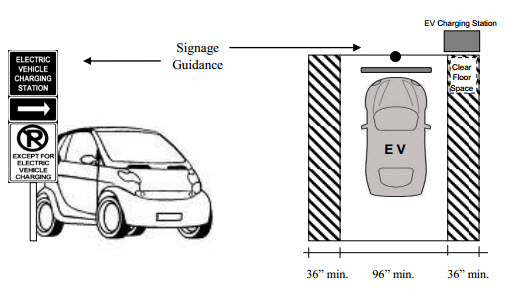
This figure is just one example. There might be other ways to meet the requirements
TM 2012-02 Emergency Response Building and Facilities
The Technical Memorandum TM 2012-02 explains what to do with facilities for emergency response personnel. This was taken from the US Access Board and DOJ Commentary. There are basically Three type of areas within emergency response facilities:
- Crew quarters that are used exclusively as a residence by emergency response personnel and the kitchens and bathrooms exclusively serving those quarters shall comply with the requirements of 233 (including 233.3.1) and 809 for residential facilities and residential dwelling units.
- All other common use areas, elements, and spaces, including, but not limited to, parking, drinking fountains, public restrooms, meeting and training rooms, and conference rooms, shall comply with the 2012 TAS. Multi-story buildings and facilities shall comply with the accessible route requirements found in 206.2.3 unless exempted by 206.2.3, Exception 2, which states that in a public building that is less than three stories with less than 5 occupants on the upper or lower story, an accessible route is not required.
- Truck bays, workshops, and other employee work areas, elements, and spaces used exclusively by emergency personnel for work shall comply with 203.9 and other provisions of the 2012 TAS applicable to employee work areas which state only approach, enter and exit is required.

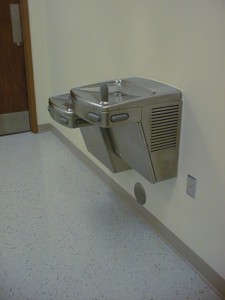

TM 2012-03 Shopping Centers and Shopping Malls
The Technical Memorandum TM 2012-03 explains what defines a shopping center or shopping mall and how this affects the elevator/accessible route exception.
The definition of a shopping center is:
a) A building housing five or more sales or rental establishments; or
b) A series of buildings on a common site, either under common ownership or common control or developed either as one project or as a series of related projects, housing five or more sales or rental establishments
If a private building is a shopping center and has more than one story, an accessible route is required, no matter what is going on on the second story.
But there is an exception if it is a retail space in a one story building with a mezzanine.
A free standing store, like Walmart is not a shopping center and therefore a mezzanine may not require an accessible route if it meets all the criteria on 206.2.3 Exception 1 or 206.2.4 Exception 3.
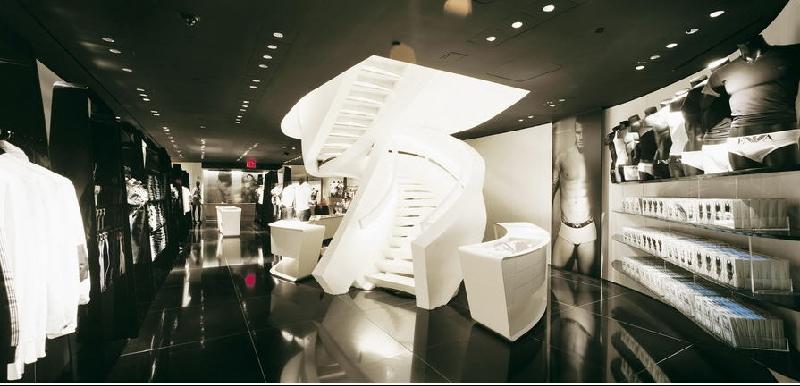
This photo is of a retail story with a second story and it does require an accessible route to the second story.
TM 2012-04 Multi-Story Buildings and Facilities
The Technical Memorandum TM 2012-04 explains what is meant by “square feet” and “per story” in 206.2.3, Exception 1:
- Square Feet. The reference to “square feet” shall mean gross square feet.
- Per Story. The term “story” is defined in 106.5.64 as that portion of a building or facility designed for human occupancy included between the upper surface of a floor or the upper surface of the floor or roof next above. A story containing one or more mezzanines has more than one floor level.
Therefore, based on 106.1 and the indicated meaning of “story”, the reference to “per story” shall also apply to the first story when calculating square footage.
These clarifications have been confirmed by the Department with the U. S. Access Board and do not constitute a substantive change to the compliance requirements of 206.2.3, Exception 1.
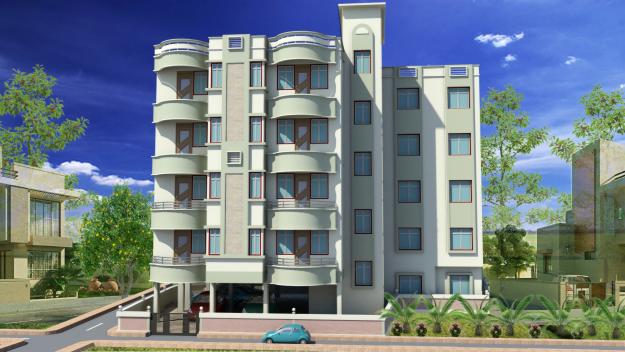
Continuing Education Opportunities
New Orleans
4 hr HSW: 2010 ADA and IBC
Please use this link below for registration and details
Little Rock
4 hr HSW 2010 ADA and IBC
Please use this link below for registration and details
If you want to learn more about the new Standards, The ADA Companion Guide explains the 2004 ADAAG Guidelines with commentary and explanations throughout. The 2004 Guidelines were adopted by the DOJ to create the 2010 Standards and by Texas to create the 2012 TAS. This book explains the technical requirements for both.
Abadi Accessibility
Front and Center
Tuesday, October 23rd, 2012In the 2010 ADA and the 2012 TAS there are certain elements that require front approach and parallel approach. But not all of those also require for them to be centered along the element. This newsletter will enumerate the one’s that do. Other elements such as lavatories and sinks and operating mechanisms only require forward approach but it is not required to be centered.
Centered Elements
602 Drinking Fountain
602.2 Clear Floor Space. Units shall have a clear floor or ground space complying with 305 positioned for a forward approach and centered on the unit. Knee and toe clearance complying with 306 shall be provided.
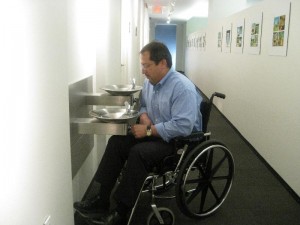
611 Washer and Dryer
611.2 Clear Floor Space. A clear floor or ground space complying with 305 positioned for parallel approach shall be provided. The clear floor or ground space shall be centered on the appliance.
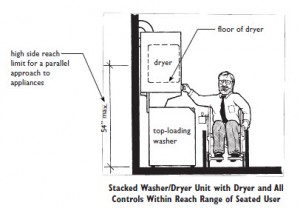
703 Signage
703.4.2 Location. Where a tactile sign is provided at a door, the sign shall be located alongside the door at the latch side. Where a tactile sign is provided at double doors with one active leaf, the sign shall be located on the inactive leaf. Where a tactile sign is provided at double doors with two active leafs, the sign shall be located to the right of the right hand door. Where there is no wall space at the latch side of a single door or at the right side of double doors, signs shall be located on the nearest adjacent wall. Signs containing tactile characters shall be located so that a clear floor space of 18 inches (455 mm) minimum by 18 inches (455 mm) minimum, centered on the tactile characters, is provided beyond the arc of any door swing between the closed position and 45 degree open position.
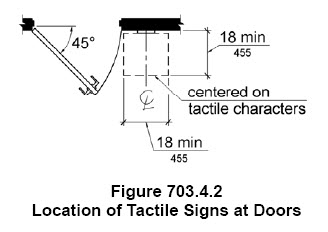
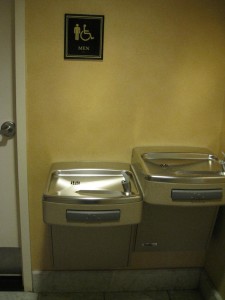
This sign has a drinking fountain in front of it, therefore the requirement for a clear floor space centered on the sign has not been met.
804.3 Kitchen Work Surface (Residential only)
804.3.1 Clear Floor or Ground Space. A clear floor space complying with 305 positioned for a forward approach shall be provided. The clear floor or ground space shall be centered on the kitchen work surface and shall provide knee and toe clearance complying with 306.
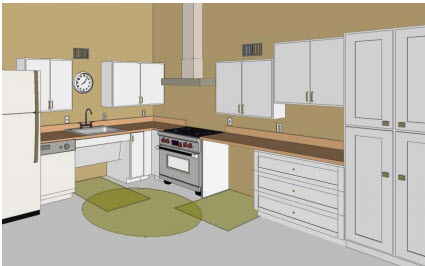
904.4 Sales and Service Counters.
EXCEPTION: In alterations, when the provision of a counter complying with 904.4 would result in a reduction of the number of existing counters at work stations or a reduction of the number of existing mail boxes, the counter shall be permitted to have a portion which is 24 inches (610 mm) long minimum complying with 904.4.1 provided that the required clear floor or ground space is centered on the accessible length of the counter.
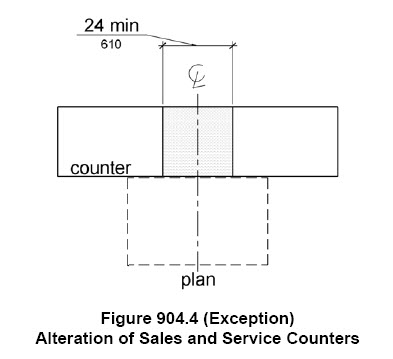
Playground Transfer Systems
1008.3.1.3 Transfer Space. A transfer space complying with 305.2 and 305.3 shall be provided adjacent to the transfer platform. The 48 inch (1220 mm) long minimum dimension of the transfer space shall be centered on and parallel to the 24 inch (610 mm) long minimum side of the transfer platform. The side of the transfer platform serving the transfer space shall be unobstructed.
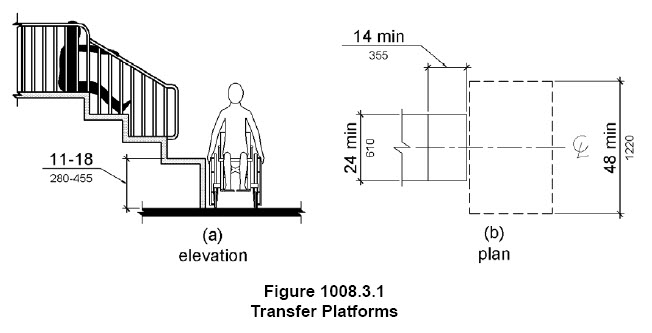
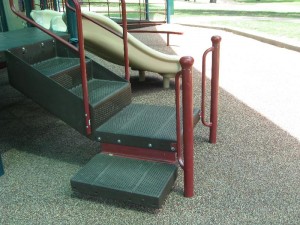
Pool Transfer Walls
1009.4.1 Clear Deck Space. A clear deck space of 60 inches (1525 mm) minimum by 60 inches (1525 mm) minimum with a slope not steeper than 1:48 shall be provided at the base of the transfer wall. Where one grab bar is provided, the clear deck space shall be centered on the grab bar. Where two grab bars are provided, the clear deck space shall be centered on the clearance between the grab bars.
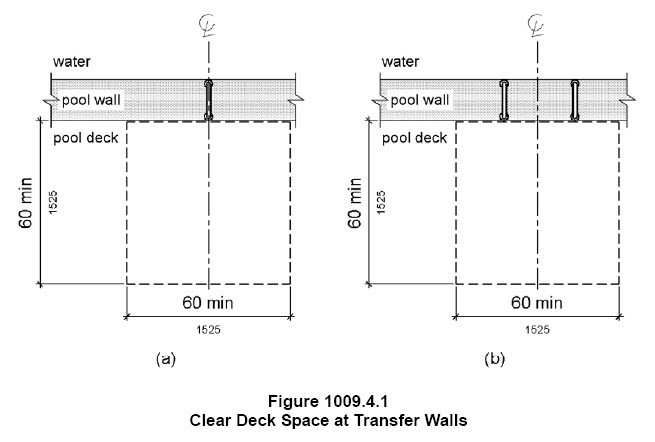
1009.4.3 Wall Depth and Length. The depth of the transfer wall shall be 12 inches (305 mm) minimum and 16 inches (405 mm) maximum. The length of the transfer wall shall be 60 inches (1525 mm) minimum and shall be centered on the clear deck space.
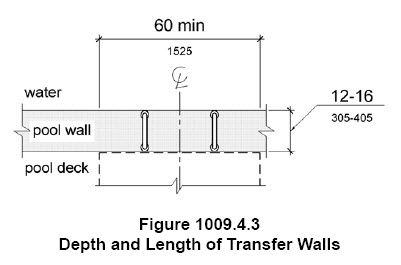
1009.5.2 Transfer Space. A transfer space of 60 inches (1525 mm) minimum by 60 inches (1525 mm) minimum with a slope not steeper than 1:48 shall be provided at the base of the transfer platform surface and shall be centered along a 24 inch (610 mm) minimum side of the transfer platform. The side of the transfer platform serving the transfer space shall be unobstructed.
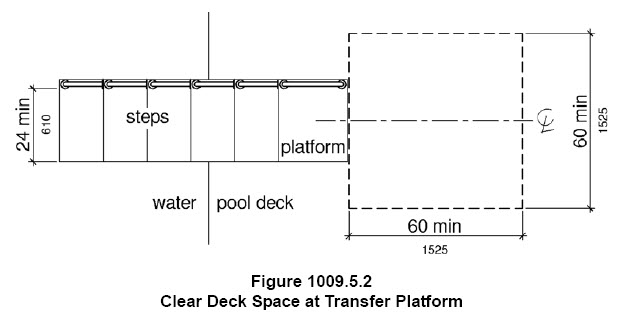
Forward Approach but not centered
The following elements are required to have a forward approach, but do not require it to be centered.
605 Urinals

606 Lavatories and Sinks
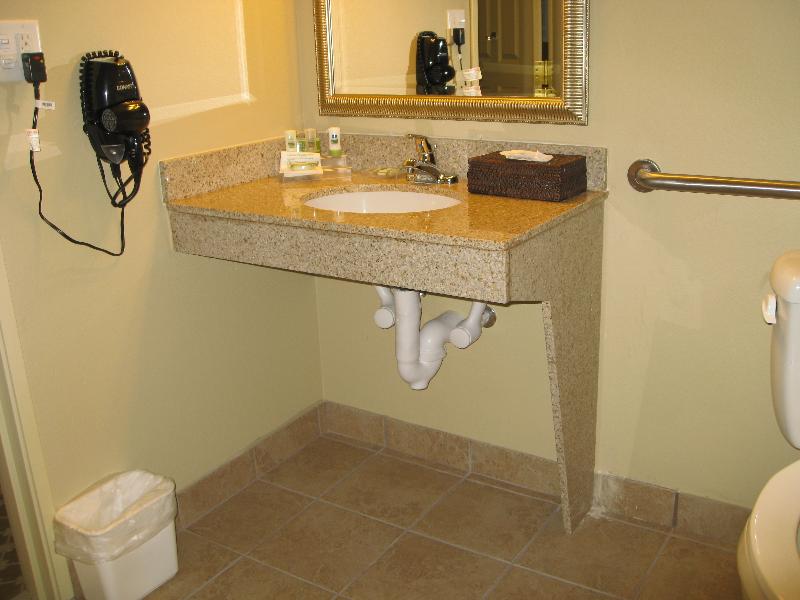
902 Dining and Work Surfaces
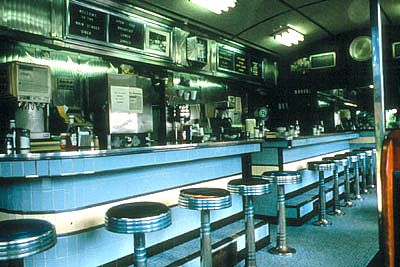
Parallel Approach bu not centered
The following elements are allowed to have a parallel approach, but do not require it to be centered.
704 Telephones
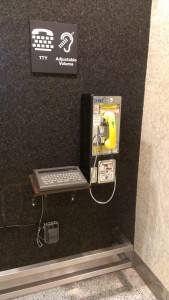
804 Range or cooktop

Photo: The range can have a parallel approach, but the sink requires a forward approach.
904 Sales Counters
If parallel approach is provided, it requires 36″ in width and 36″ in height plus the same depth as the main counter
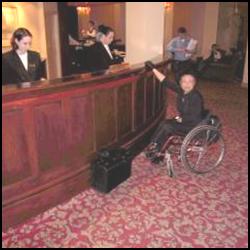
Photo 1: This photo is of a service counter/reception desk at a hotel that did not provide the 36″ wide x 36″ high counter
If forward approach is provided, it requires 30″ in width and 36″ in height, plus the same depth as the main counter and a knee and toe space per 306
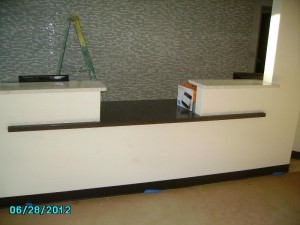
Photo 2: This counter has provided a lower portion that meets the requirements for the parallel approach. (photo provided by Structures and Interiors)
602 Exception at Drinking Fountains for children
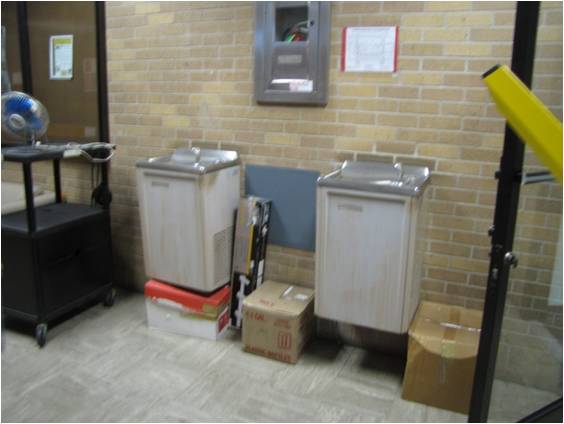
606 Exception at sinks in kitchens without a cooktop or range
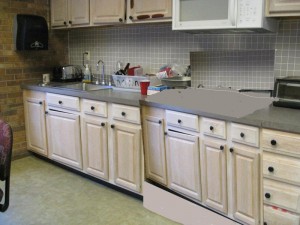
Photo: This kitchen has a built in microwave but NO cooktop, therefore it can take the exception for parallel approach at the sink.
606 Exception at Wet bars
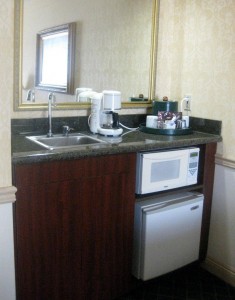
606 Exception at lavatories or sinks for children under 5
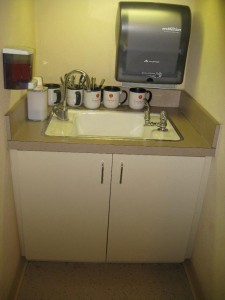
804 Freezers or Refrigerator in kitchens
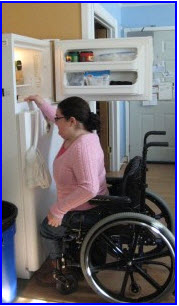
Continuing Education Opportunities
November 2- International Facilities Managers Association Convention in San Antonio, Texas
November 7- provided by SSTL Codes 4 hr ADA seminar in Tulsa OK
If you want to learn more about the new Standards, The ADA Companion Guide explains the 2004 ADAAG Guidelines with commentary and explanations throughout. The 2004 Guidelines were adopted by the DOJ to create the 2010 Standards and by Texas to create the 2012 TAS. This book explains the technical requirements for both.
Abadi Accessibility
Knee space at sinks
Thursday, August 23rd, 2012In the 2010 ADA and the 2012 TAS requires that 5% but no less than 1 sink must be accessible. One of the requirements of accessibility at sinks is to have a knee space under the sink. But there is a new exception:
606.2 Clear Floor Space Exception 1: A parallel approach complying with 305 shall be permitted to a kitchen sink in a space where a cook top or conventional range is not provided, and to wet bars.
The Texas Department of Licensing and Regulation issued a bulletin that explains when this exception can be taken and when it cannot. This newsletter will explain it as well.
Break Rooms
Does my sink at my break room have to have a knee space?
It depends (don’t you love that answer?)…..
It depends on whether the break room is a kitchen or not. But it can’t be our definition of a “kitchen”, but the dictionaries definition. When dealing with terms that the ADA and TAS do not define, we are directed by the US Access Board to use the Webster’s definitions:
– Kitchen: A place (as a room) with cooking facilities.
– Kitchenette: A small kitchen or alcove containing cooking facilities.
– Wet Bar: A bar for mixing drinks that contains a sink with running water.
– Cooking Facilities: Fixed or built-in range, cook top, oven, microwave, or convection oven.
-Fixed Appliance: When attached to a cabinet, shelf or other surface or to a gas supply.
-Built -In Appliance: When cabinetry design or location of utilities (i.e.. gas supply or 220V electrical outlets) creates a dedicated shelf or space for the appliance.
So, if a break room has “cooking facilities” within, then it is a kitchen.
If it is a kitchen and has a cook top or a range, then a knee space at the sink will be required.
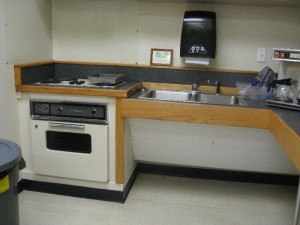
But if the break room has a built in microwave or oven, then it will still be considered a “kitchen” but now the sink can take the exception and have a parallel approach rather than a front approach.

This break room has a microwave on top of the counter. This is not considered a “fixed cooking facility”, therefore this space is not a ‘kitchen” and the sink will require a knee space.
If our space is not a true kitchen based on the definition, then if there is storage located within, it must comply only with Scoping 225 which says that at least one of the storage units must comply with 811 and be within reach range. This is important, because if we truly have a kitchen, there would be many more requirements associated with them. See the next entry for those.
212 and 804 Kitchens, Kitchenettes and Sinks
Based on the definition we discussed earlier, if the space is truly a kitchen, then certain requirements will be listed in the scoping of the ADA and TAS:
- 5% of sinks but no fewer than one must comply with 606
- And they must follow the technical standards of section 804
Section 804 states that kitchens must follow the following requirements:
- Floor clearances must be provided depending on the configuration of the kitchen
- A work surface in a “residential” kitchen will require an additional knee space not under a sink. To understand about what is considered “residential”, you can read our July edition of our newsletter
- Heights of work surfaces must be 34″ high max above the floor
- Sinks shall comply with 606
- 50% of the shelf space in storage shall comply with 811 (measured in linear feet)
This is an important one! In order for this to be able to be compliant, the shelves must be within reach range. Which means that if a kitchen has upper cabinets and base cabinets, the number of linear feet of shelving must be the same for the non-accessible ones than for the accessible ones. This could be problematic since at the base cabinets there is typically appliance, knee spaces and no shelving. - Appliances in kitchens must be accessible and follow requirements listed in 804.6
Commercial kitchens are exempted from having to comply with these requirements since they are part of a “work area”
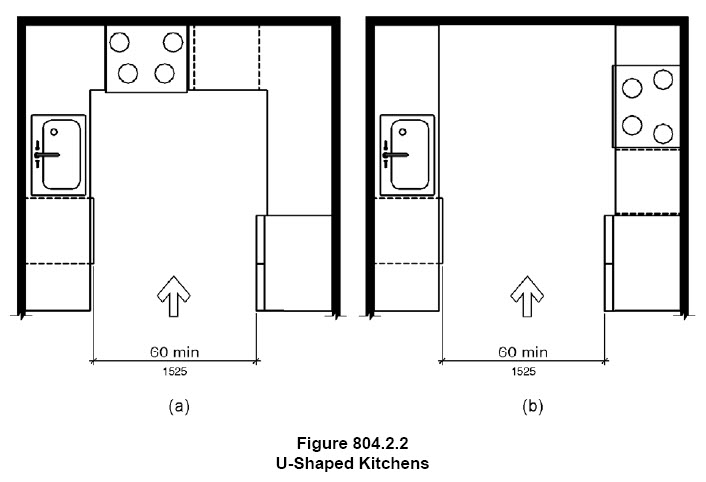
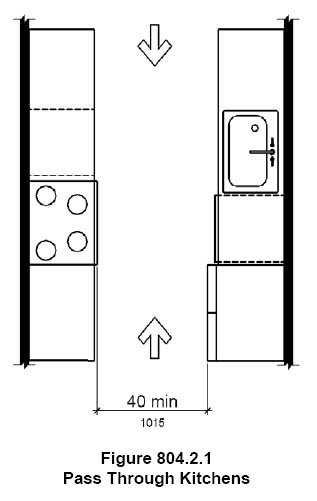
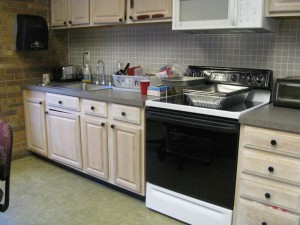
Wet Bars and other Sinks
Another location where a knee space at a sink is not required is at wet bars. Wet bars are defined in our first entry, but it is a place where drinks are mixed. They are typically found either at hotels and other transient lodging places or sometimes even at waiting rooms. According to TDLR, a break room is not a wet bar.
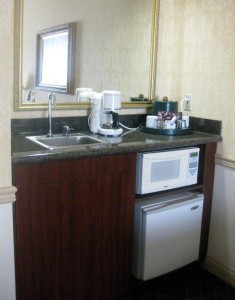
This is a wet bar and does not require a knee space
The other sinks that must follow the scoping of 212 and the technical requirements of 606 are common use sinks such as science labs at a school.
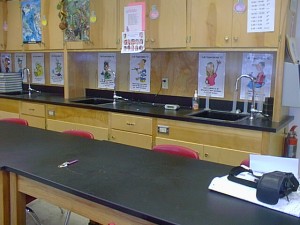
But sinks that are not common use, but are part of a work area and are only used for work related activities are exempted as a “work area”. These are located in teacher workrooms, back of bar at a restaurant, or commercial kitchens.
Continuing Education Opportunities
August 9th- Metrocon12 in Dallas Texas “2012 TAS in interior projects”
September 5th- AIA Dallas Procrastinator’s day
September 12th- CSI’s Construct Show at Phoenix Arizona
November 2- International Facilities Managers Association Convention in San Antonio, Texas
If you want to learn more about the new Standards, The ADA Companion Guide explains the 2004 ADAAG Guidelines with commentary and explanations throughout. The 2004 Guidelines were adopted by the DOJ to create the 2010 Standards and by Texas to create the 2012 TAS. This book explains the technical requirements for both.
If you have any questions about these or any other topics, please feel free to contact me anytime.
Abadi Accessibility
What is a Kitchen according to TDLR
Thursday, July 12th, 2012TDLR issued a new RAS bulletin for projects that are built in Texas. Here is the link . I also wrote my August newsletter that explains it:
In summary, here is the issue:
The following terms are not defined in TAS, therefore, based on 106.3, definitions provided in collegiate dictionaries, and information received from the U.S. Access Board, they shall have the referenced meanings:
– Kitchen: A place (as a room) with cooking facilities.
– Kitchenette: A small kitchen or alcove containing cooking facilities.
– Wet Bar: A bar for mixing drinks that contains a sink with running water.
– Cooking Facilities: Fixed or built-in range, cooktop, oven, microwave, or convection oven.
-Fixed Appliance: When attached to a cabinet, shelf or other surface or to a gas supply.
-Built -In Appliance: When cabinetry design or location of utilities (ie. gas supply or 220V electrical outlets) creates a dedicated shelf or space for the appliance.
For purposes of compliance with 212 and 804, the terms “kitchen” and “kitchenette” shall be used interchangeably.
With Cooking Facilities: A room or space with at least one fixed or built-in cooking facility is considered a kitchen/kitchenette and shall be subject to compliance with 212 and 804. Storage required by 804.5 shall be calculated by linear feet.
Section 212 Kitchens and Kitchennettes:
212.1 General. Where provided, kitchens, kitchenettes, and sinks shall comply with 212.
212.2 Kitchens and Kitchenettes. Kitchens and kitchenettes shall comply with 804.
212.3 Sinks. Where sinks are provided, at least 5 percent, but no fewer than one, of each type provided in each accessible room or space shall comply with 606.
EXCEPTION: Mop or service sinks shall not be required to comply with 212.3.
Section 804 Kitchens
These are the technical guidelines for kitchens in common use spaces, residential dwelling units and transient lodging spaces.
804.5 Storage (in kitchens): At least 50 percent of shelf space in storage facilities shall comply with 811. This is measured in linear feet.
According to TDLR, the photo above would be considered a kitchen with cooking facilities because there is a built in range and built in microwave. Therefore the sink would require a knee space per section 606.2 and be at 34″ high max.
If the same kitchen had a fixed oven only, or a fixed microwave only without a cooktop, then it would still be a kitchen but now the sink would NOT require a knee space.
Without Cooking Facilities: A room or space without a fixed or built-in cooking facility shall be subject to compliance with all applicable provisions of TAS based on the elements provided. 606.2, Exception 1 shall NOT apply to sinks provided in spaces without cooking facilities unless it is a wet bar since this exception is applicable only to kitchen sinks. Storage provided shall comply with 225 and 811.
Section 606 Sinks and Lavatories
606.2 Clear Floor Space. A clear floor space complying with 305, positioned for a forward approach,
and knee and toe clearance complying with 306 shall be provided.
Exceptions:
1. A parallel approach complying with 305 shall be permitted to a kitchen sink in a space where a
cook top or conventional range is not provided and to wet bars.
3. In residential dwelling units, cabinetry shall be permitted under lavatories and kitchen sinks
provided that all of the following conditions are met:
(a) the cabinetry can be removed without removal or replacement of the fixture;
(b) the finish floor extends under the cabinetry; and
(c) the walls behind and surrounding the cabinetry are finished.
4. A knee clearance of 24 inches (610 mm) minimum above the finish floor or ground shall be
permitted at lavatories and sinks used primarily by children 6 through 12 years where the rim or
counter surface is 31 inches (785 mm) maximum above the finish floor or ground.
5. A parallel approach complying with 305 shall be permitted to lavatories and sinks used primarily
by children 5 years and younger.
6. The dip of the overflow shall not be considered in determining knee and toe clearances.
Section 225 Storage
225.2 Storage. Where storage is provided in accessible spaces, at least one of each type shall comply with 811.
811 Storage
This section describes the techincal requirements for storage in common use accessible spaces including common use, residential and transient lodging. (but they are different than in kitchens which should follow 804.5)
811.1 General. Storage shall comply with 811.
811.2 Clear Floor or Ground Space. A clear floor or ground space complying with 305 shall be
provided.
811.3 Height. Storage elements shall comply with at least one of the reach ranges specified in 308.
811.4 Operable Parts. Operable parts shall comply with 309.
The photo of the sink above shows a sink that is not located at a kitchen as defined by TDLR since there is no “fixed” cooking facility. We see the microwave but it is not fixed. Therefore a knee space is also required at this location.
Wet Bars: A bar used for purposes other than drink preparation is not considered a wet bar.
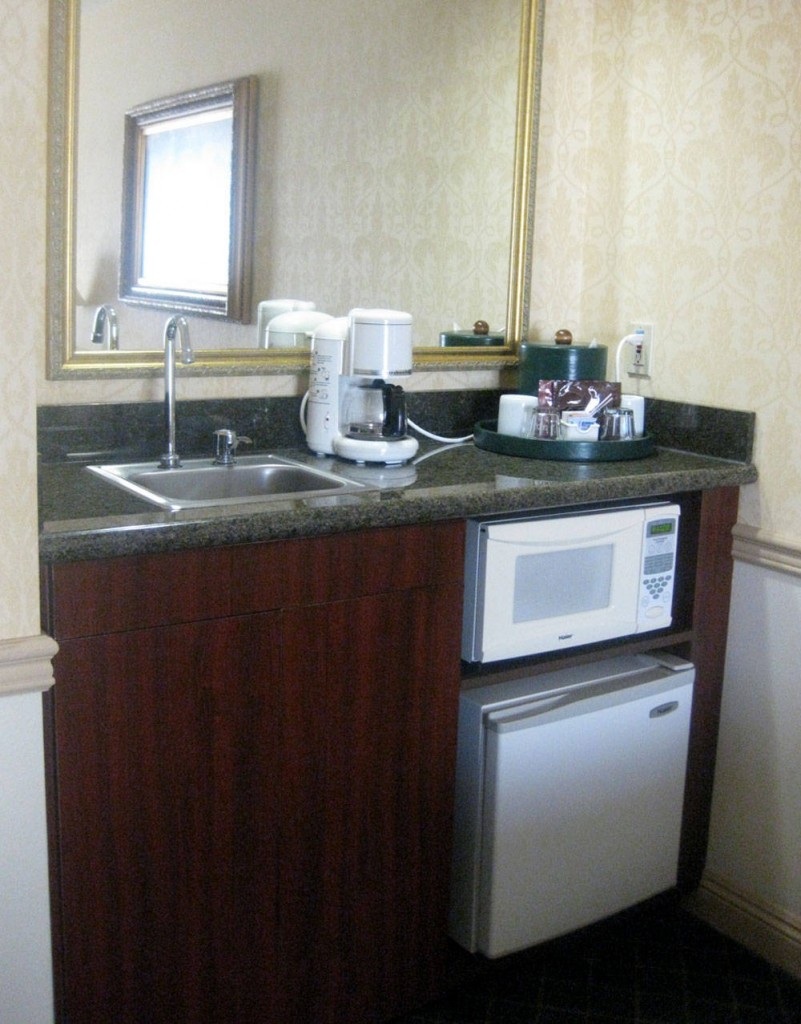
Summary: Kitchens, Kitchenettes, and Comparable Spaces. This table explains when and how many kitchens are required to comply.
Basically, kitchens and ktichennettes in common spaces, must comply with sections 212 and 804 of the 2012 TAS (as well as the 2010 ADA).
Kitchens at residential facilities must comply with sections 233 and 809
Kitchens at Transient lodging must comply with 224 and 806
Kitchens at work areas do not have to comply. These are commercial kitchens or kitchens used for work purposes.
Some kitchens require a separate work surface with a knee space but only at residential and transient lodging places.
Storage not in a kitchen (such as a break room without a fixed cooking facility) will have to comply with 811 and only one of each kind will have to comply.
Storage in kitchens at residential and transient lodging do have to comply with the 50% rule.
For facilities without cooking facilities within and in common use spaces, residential dwelling units and transient lodging, are not considered kitchens. Therefore if they have a sink they must comply with the requirements for sinks listed in 606.2 and are not subject to Exception No. 1 unless it is a wet bar. They also would not be subject to the storage requirement since they are not kitchens. Break rooms are good examples of such facilities. They are not kitchens because they don’t have a built in cooking facility, but must comply with the requirements for sinks.
Is the accessibility of your business good business?
Tuesday, June 12th, 2012This guest blog is brought to you by my friend William J. Martin, WJM Architect (photo credit Mike Pollio). I met William on Twitter and have been following his amazing work for over two years. He is amazing and I’m grateful and flattered that he decided to write a blog post for our site. Enjoy!
What prevents businesses from making the changes that make their businesses handicap accessible has many parts. Many business owners tell me it’s about money and construction cost — a big investment without any financial return. I do understand that no one likes to spend money on things they don’t believe necessary to operate their business, but what if it turns out to be good business?
Sometimes events occur that help to illustrate the value of consulting with an accessibility design professional to bring your business into compliance with the accessibility codes and the Americans with Disabilities Act (ADA) requirements.
I recently had a project that involved ADA upgrades to a long established restaurant. This particular project was not that much different than many of the other projects that I had designed in the past, with one exception…. It was severely damaged by fire and was over 140 years old. It was damaged, but not destroyed. The beloved building would be repaired and rebuilt.
Whenever there is a fire in a building, it is a tragedy. If the building is 140 years old and has a fire, it is a serious tragedy. Buildings like that are vital to the heritage of their community. Having something as permanent as a beloved local building damaged by fire can be extremely unsettling for many people.
My client called me the day after the fire and said “This building is 140 years old, we have been here for 40 years, we just had a severe fire. You have to help me!”
After I saw the damage and got over my personal shock, I comforted the owners, “don’t worry,” I said, “the structural damage can be repaired.” I then began to contemplate the task at hand. My client would have loved to blink his eyes and have everything put back exactly as it was before the fire. However, the extent of the damage was more than sufficient to require building code upgrades, including accessibility upgrades. The multilevel interior dining rooms would have to change. Toilet facilities would have to be addressed.
After assisting in obtaining the cleanup and selective demolition permit, the very next thing I did was to prepare a comprehensive building code analysis to identify the exact upgrades that would be required based on the extent of the damage. This had to be done first, since it affected the overall approach to the fire damage repair and rebuild design work. I met with the building officials and had them review and sign off on the code analysis and required upgrades. This way I had a clear and unchanging set of requirements specific to this project. The full extent of required upgrades were established and I could now begin the redesign work.
With significant concern in his eyes my client said… ”I can’t lose paying customer tables and seats for ramps and toilets that I did not have before the fire. You have to help me! I assured him I would do the very best I could to resolve all issues and get the restaurant open as soon as possible. His response was direct, “If it was so easy, don’t you think I would have made those handicap changes already.” [Note: we prefer the word accessible rather than handicap]
This was a normal reaction from a very savvy businessman assessing a difficult situation. For an accessibility design professional , this was a design problem to be solved.
Armed with my ADA/ANSI code analysis, I began to look for solutions. The dining rooms were 2 steps up and down from one another. It seemed like there were steps everywhere. The ladies toilet rooms were on the second floor, a full flight of stairs up from the dining rooms. The mens toilet room was actually 2 small individual toilet rooms just off the dining room. The 140 year old wood framed building had been a Victorian house, a hotel, rooming house, bar, and finally, most recently, the fire damaged restaurant.
Built right up to the street line, there was no front yard for any kind of ramp.
The main building had long ago been connected and combined with the buildings next door. These connected buildings were why every floor was at a different level. They were built as separate buildings and combined later into the dining rooms, kitchen and bar of the restaurant.
The old connected storefront was previously converted into an emergency exit and alarmed to prevent casual use. Even though there was a step to the doorway, the recess of the storefront allowed for a ramp to meet the sidewalk. There was my new accessible entry. The four steps up at the existing traditional entry could remain as I designed this entry adjacent to serve as a new ramped entry. There were no tables allowed in front of this emergency exit, so no tables and chairs were affected by this change.
Next the dining room levels had to be addressed. I could get a ramp in from outside, but now I had to find an accessible route within the space. The 14 inch difference between floor levels meant a 14 foot long ramp in the dining rooms with landing space, railings, turning clearances, etc. This would certainly affect tables and chairs in the dining rooms and this was what my client felt was devastating to his restaurant seat count. I began to get a headache.
Since circulation space could also serve as ramp landing space, I analyzed the circulation around the tables and the kitchen area. The kitchen was also 2 steps higher than the dining room. The hallways connecting the dining rooms to the kitchen could not be used for tables regardless.
Instead of a single 14 foot long ramp, I designed two 7 foot ramp sections — one in each dining room using these existing hallways. The two ramps met at a new mid level where I created a comfortable landing with proper turning radius. Kitchen entry was shifted over slightly. The fire had begun in the kitchen and this doorway move could be done easily during the kitchen redesign.
Adjacent to the new ramp landing space was a large storage closet where beverages were dispensed and glasses stored. I relocated the beverage function into the new efficient commercial kitchen design and used this closet space for a unisex accessible toilet room.
I aligned the toilet room floor at the new landing mid level, with the door to the toilet room opening off the ramp landing. There was proper clearance for the ramps, turning, handrails, and the required toilet room door approach clearances. The closet interior was slightly larger than was needed for the a compliant toilet room.
I now had the interior accessible route connecting the dining room levels and the required unisex handicap toilet room. This was accomplished without displacing a single customer seat.
After I confirmed all of the many overlapping ADA clearance requirements, I grabbed my sketch and met with the owner to explain how it would work. At first he could not believe it. The ramps were much shorter than he was told would be necessary. When I explained the new mid level between the two ramps, his eyes grew big as he realized that it was possible after all.
Nearly any building can be made accessible, it’s really a matter of architectural creativity and open minded problem solving.
The fire damaged restaurant, with the handicap accessibility changes, was completed and re-opened. Like any beloved neighborhood business, the outpouring of public support resulted in increased business in the weeks and months since the re-opening.
I suggested to the owner that they include in their advertising a few words about the new accessible features. The result has been a sustained increase in their business. Able bodied people now bring disabled relatives to eat. More elderly patrons, many with only minor mobility issues, now flock in groups to enjoy the best burgers around. Some people come just to see the inside of the 140 year old building. They never thought they would be able move freely between the levels and now they come just because they can.
In the end my client told me the changes that were made, made good business sense. People who had difficulty entering the restaurant because of the front steps now come to dine and bring with them their families and friends AND their dollars…
Accessibility professionals know that making your business accessible isn’t just part of the building code, it’s good for your business.
Over the years I have assisted businesses and witnessed them benefit substantially from handicap accessible modifications made to their buildings, especially service businesses.
Accessibility for all is good business.
March 2012
Friday, March 23rd, 2012“Every rule is meant to be broken”. Even though the ADA standards are guidelines to making the built environment more accessible and help eliminate architectural barriers, there are also exceptions which take into consideration some real world situations.
Tenant finish out
In existing buildings, if an alteration occurs then, depending on where the alteration happens, certain elements must be brought up to compliance. If the alteration is inside an area that contains a primary function of the building, then not only the space being altered must be compliant, but also the path of travel and elements along the path of travel must also comply. But the 2010 ADA (as well as the 2012 TAS) has an exception if the alteration is being done by a tenant in a building:
If a tenant is making alterations as defined in [DOJ CFR] § 36.402 that would trigger the requirements of this section, those alterations by the tenant in areas that only the tenant occupies do not trigger a path of travel obligation upon the landlord with respect to areas of the facility under the landlord’s authority, if those areas are not otherwise being altered.
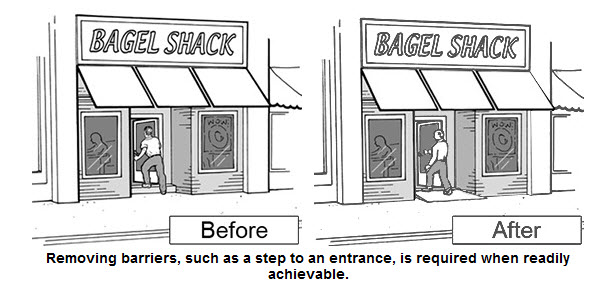
In other words, now even if the tenant is remodeling an area of primary function, only his space must comply, but not the path of travel owned by the landlord unless that path of travel, restrooms along the path of travel etc. are also being altered.
Knee spaces at sinks
In sinks and lavatories a forward approach knee space is required. This allows a person that uses a wheelchair to wash their hands, or even wash any dish if they need to.
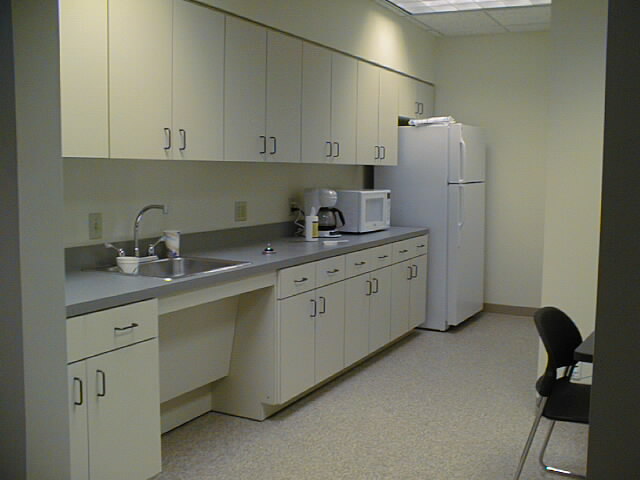
But in the 2010 ADA Standards, there is an exception for sinks that are located in kitchens that do not have a cooktop. A parallel approach in those kitchens are allowed. Although the height of 34″ max is still required.
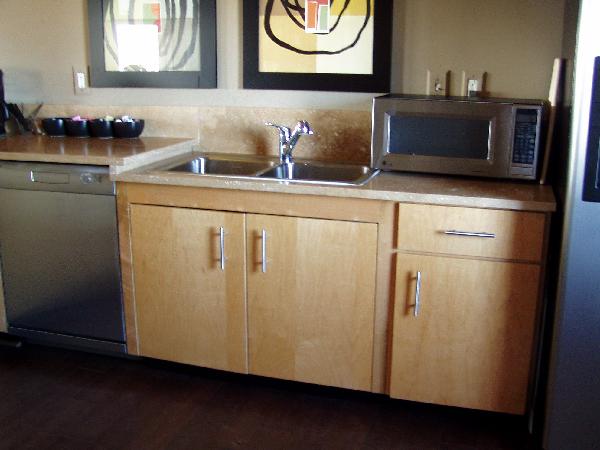
Inspector’s Corner
Back by popular demand. I am bringing back my Inspector’s corner
In this inspection, we had a recessed lavatory and a water closet on the adjacent wall. This recessed lavatory allows the rear grab bar to be 24″ in length rather than the required 36″ in a typical water closet, centered on the water closet
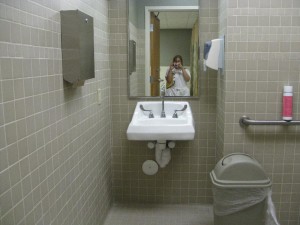
What’s next….
Need CEUs?
March 6th- “Human Services: Comparing Standards” and “Understanding the 2012 TAS for Interiors” TAID Seminar at 9:15 and 1:00 p.m. at the Design Center
March 8th- “Understanding the 2012 TAS” CSI Chapter Meeting from 7-8 p.m.
March 20th- “Understanding the 2012 TAS” at Procrastinator’s Day at AIA Dallas at 2:00 p.m.
March 29th- SSTL Codes ” A Comprehensive Summary of the 2010 ADA Standards”
5 hrs CEU (good for California CEUs)
March 30th- “Navigating through the 2012 TAS” presented at the CREST Annual Expo at 3:00 p.m. in the Dallas Convention Center
If you want to learn more about the new Standards, The ADA Companion Guide explains the 2004 ADAAG Guidelines with commentary and explanations throughout.
Online CEU course by the AIA National : The ADA and Urban Regeneration (as presented in the 2011 AIA National convention)
Abadi Accessibility
 Abadi
Abadi 

